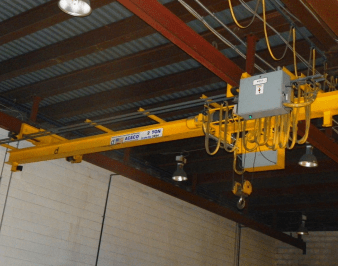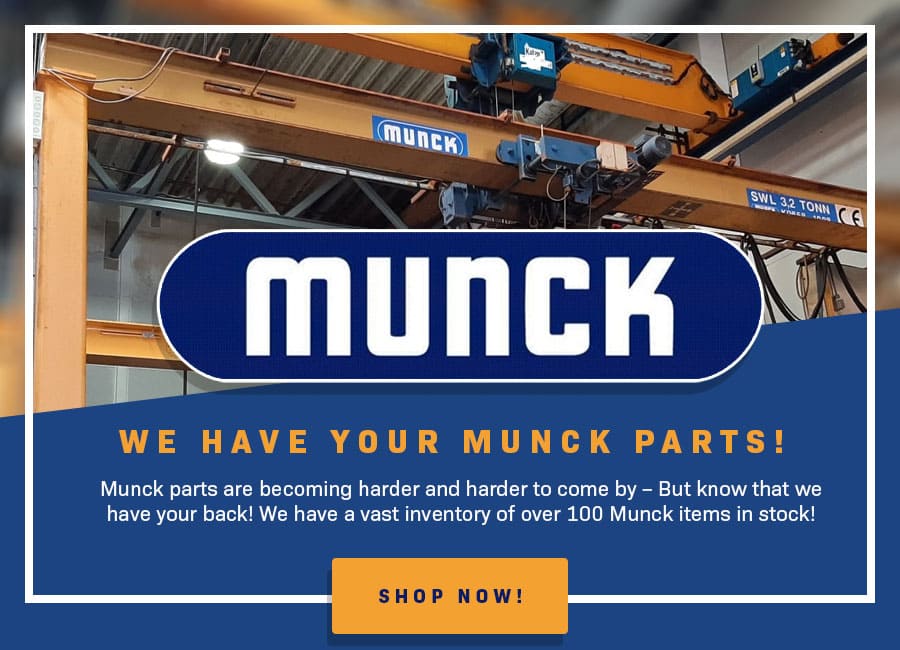Almost any industry utilizes overhead cranes and hoists. There is a wide variety of overhead lifting equipment to fit any use, so how can you select the right equipment for your particular application? Since crane choice is so important for workers’ safety as well as maintenance and inspection requirements, the Crane Manufacturers’ Association of America (CMAA) has established crane service classifications to make it easier to choose.
Crane & Hoist Classifications
Class A – Infrequent or Standby
These cranes are best for precise handling at slow speeds. They are good choices for powerhouses, public utilities, turbine rooms, motor rooms, and transformer stations.
 Class B – Light Service
Class B – Light Service
This class is ideal for environments with light service requirements and low speed needs. They can handle two to five lifts per hour, and work well for repair shops, light assembly operations, service buildings, and light warehousing.
Class C – Moderate Service
These cranes are built for use in machine shops, papermill machine rooms, and other such environments with moderate service requirements. They can handle loads that average 50% of the rated capacity, making five to ten lifts per hour, with not over 50% of the lifts at rated capacity.
Class D – Heavy Service
These cranes may be used in heavy machine shops, foundries, fabricating plants, steel warehouses, container yards, lumber mills, etc., and standard duty bucket and magnet operations where heavy-duty production is required. In this type of service with 10 to 20 lifts per hour averaging 15 feet, not over 65 percent of the lifts at rated capacity.
Class E – Severe Service
These cranes are capable of handling loads approaching a rated capacity throughout its life. Applications may include magnet, bucket, magnet/bucket combination cranes for scrap yards, cement mills, lumber mills, fertilizer plants, container handling, etc., with twenty of more lifts per hour at or near the rated capacity.
Class F – Continuous Severe Service
These cranes must be capable of handling loads approaching rated capacity continuously under severe service conditions throughout its life. Applications may include custom designed specialty cranes essential to performing the critical work tasks affecting the total production facility. These cranes must provide the highest reliability with special attention to ease of maintenance features.
Crane Selection Criteria
So what class crane best suites your particular manufacturing needs and environment? Review the following important criteria when selecting the right overhead crane:
Speed – Measured in lifts per hour, this is how quickly the crane is able to move materials and equipment.
Service – The crane’s frequency of use.
Distance – The distance a crane needs to move the lifted materials.
Rated Capacity – The average rated load of materials moved determines rated capacity.
Maintenance Requirements – How often the crane needs to be serviced.
Service Conditions – The environment in which a crane will operate, and its access for servicing, are important factors.
Strength of Our Products
At American Crane & Equipment Corporation, our cranes are manufactured to CMAA Specifications 70 or 74. We can also supply cranes that meet ASME, NUM-1 and NOG-1 requirements.
- Our products are carefully manufactured to meet each customer’s specific need.
- Our equipment can be used in critical environments where safety cannot be compromised.
- We make our products to meet and exceed customer expectations.
- Our equipment is built with quality, reliability, and enhanced safety in mind.
- We have a large inventory of parts and components available to be shipped the same day.
When in Doubt, Consult the Experts
For over 40 years, American Crane & Equipment Corporation has been one of the most innovative manufacturers of high-quality, specialty lifting solutions for unique applications and environments. Our overhead crane solutions experts are available to answer any questions you have about crane installation, operation, and maintenance as they relate to your particular industry. Download our eBook, Understanding Crane and Hoist Classifications, for answers to your product questions.
You can also contact the American Crane team now by clicking here.





